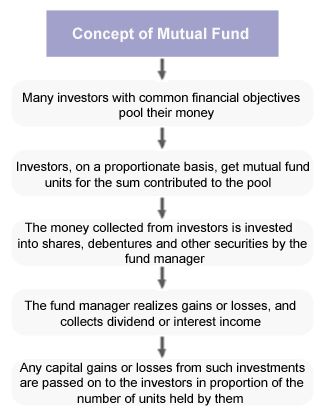Mutual funds are one of the most common avenues which investors have today. They provide good investment opportunities to the present day investors.

Like all investments, mutual funds involve some risks. The investors should compare the risks and expected returns after examining other instruments before making the decisions relating to such investments.
This article tends to make an attempt to provide information in question-answer form to make the investors aware of the nature and benefits of mutual funds that might help them in taking the right decisions.
What do you mean by a Mutual Fund?
Mutual fund is a process for depositing money by issuing units to the investors through funds in securities as per the objectives stated in an offer document.
Investments in securities are very common in industries and sectors but involving high risk as they are all diversified as all stocks do not move in the same direction at the same time.
However Mutual funds issue units to the investors according to the amount of money invested by them. The Investors of mutual funds are termed as unit-holders.
In a mutual fund the gains or losses are shared mutually by investors in proportion to the investments made by them.
Mutual funds appear with a number of schemes that are introduced from time to time with different investment motives.
A mutual fund should be registered with Securities and Exchange Board of India (in short known as “SEBI”) before it gathers funds from the common people.
The history of Mutual Funds in India:
Unit Trust of India was the first mutual fund in India formed in 1963. In late 1980s, the Government gave the liberty to the public sector banks and institutions to from mutual funds. In 1992, Securities and Exchange Board of India Act was passed.
Role of SEBI in mutual funds industry:
The objectives of SEBI are as follows:
- To protect the welfare of the investors in securities;
- To promote the development of the securities market.
Securities and Exchange Board of India formulates policies and controls mutual funds to protect the welfare of the investors.
It also used to notify regulations for mutual funds from 1993. Thereafter, mutual funds sponsored by private sector entities entered the market.
The regulations were amended in 1996 and thereafter from time to time. It also issued guidelines through circulars to mutual funds to protect the investors.
All mutual funds, whether promoted by Indian sector or by foreign entities, are governed by the same Regulations. There is no distinction in the rules and regulations and all are subject to inspections by the Securities and Exchange Board of India.
Setting up of a mutual fund:
A mutual fund is formed as a trust, having a sponsor, trustees and a custodian. The trust is formed by a sponsor who is like the promoter of a company.
The trustees hold its property for the welfare of the unit holders. The funds are managed by making investments in many kinds of securities.
The Custodian keeps the securities of the schemes of the fund in its custody. The trustees are vested with the power of superintendence over AMC. They keep a watch at the compliance of SEBI Regulations by the mutual fund.
Is registration of mutual funds mandatory?
All mutual funds should be registered with SEBI before launching a scheme.
What is Net Asset Value?
The performance of any scheme of a mutual fund is represented by Net Asset Value.
Different types of mutual fund schemes:
Schemes according to Period of their Maturity – A mutual fund scheme can be classified into the following types depending on its maturity period:
Open-ended Scheme – An open-ended scheme is available for subscription on a continuous basis. They do not have a fixed maturity period. Investors can purchase and sell units at Net Asset Value which is declared daily. The main feature of these schemes is liquidity.
Close-ended Scheme – A close-ended scheme has a specified maturity period and is open for subscription only during a particular time of launch of the scheme. Investors can invest at that time and thereafter they can buy or sell the units on the stock exchanges where they are listed.
Schemes according to Investment Objective – A scheme is also classified in the following – Growth Oriented Scheme; Income Oriented Scheme; Balanced Scheme; Money Market Schemes.
How to invest in a scheme?
Investors can contact the agents of a mutual fund who are spread throughout the country for the required information and application forms.
Investors have to ensure that they make their investments in such funds through distributors registered the Association of Mutual Funds in India and that such distributor has a valid Registration Number.
Also read:
If you think investing in mutual funds or SIP is simple, think again